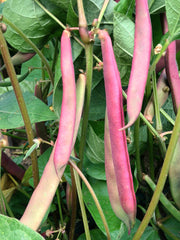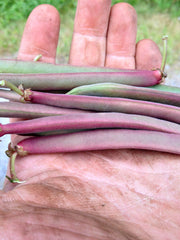Bean, Bush Snap 'Tanya's Pink Pod'
(P. vulgaris) Truly a remarkable bean in growing habit, taste, and appearance. Large (6”), flat, and wonderfully tasty pods of a uniquely beautiful iridescent hot pink color that remind us quite a bit of magentaspreen. The bushy plants are very productive over a long period. You need not fret if you miss the fresh eating stage, as they also make a tasty cooked dry bean. Discovered as a sport in the garden of Salt Spring Seeds owner Dan Jason by his then apprentice, Tanya, over a decade ago, this bean has grown true ever since. Many thanks to Dan for sharing this one with us!
40-50 days fresh, 90 days dry. UO
Packet: 1oz (~60 seeds)
Availability: In stock
Growing Info
SOWING:
Direct seed after the last frost date when the soil has warmed.
Note: Beans prefer well-drained, warm soil.
PLANTING DEPTH:
1"
SPACING:
3-5" between plants with 12-24" between rows*
*Pole beans require 5+' between rows.
EMERGENCE:
5-10 days @ soil temp 65-90F
LIGHT:
Full sun to part shade
FERTILITY:
Light to Moderate. Beans can produce their own usable nitrogen from atmospheric nitrogen through a symbiotic relationship with bacteria that colonize specialized nodules in their roots. Too much soil fertility can cause excessive vegetative growth at the expense of pod set and maturity.
Beans prefer well-drained warm soil with a pH between 6.0-7.0.
ADDITIONAL NOTES:
Beans prefer warm soils and may rot at lower temperatures. This is particularly true for white-seeded varieties. You love beans. Patience.
It can be quite beneficial to mix bean seeds with commercially available bacterial "inoculants" to encourage the beneficial symbiotic relationship in the growing plant's root nodules, especially if growing on ground that hasn't been planted with beans before. This can increase yields and improve plant health.
Avoid picking/weeding beans when the plants are wet. This will help prevent the spread of disease.
Provide a trellis for pole beans.
White-seeded varieties are more susceptible to rot when seeded in cool, wet, early-season conditions.
Sow Snap Beans every few weeks for continued harvests.
Harvest dry beans when the pods are brown and dry.




